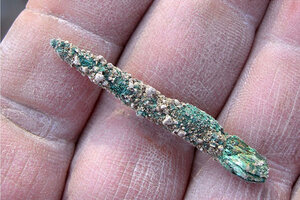Archaeologists awl worked up over ancient piercing tool
A copper awl unearthed in Tel Tsaf, an archaeological site in Israel, indicates the presence of a vast metal trade hundreds of years earlier than previously thought.

A copper awl was discovered at the archaeological site Tel Tsaf in the Jordan Valley of Israel, dating to 5100 B.C. to 4600 B.C.
PLOS ONE, doi: 10.1371/journal.pone.0096882
A copper awl is the oldest metal object unearthed to date in the Middle East. The discovery reveals that metals were exchanged across hundreds of miles in this region more than 6,000 years ago, centuries earlier than previously thought, researchers say.
The artifact was unearthed in Tel Tsaf, an archaeological site in Israel located near the Jordan River and Israel's border with Jordan. The area was a village from about 5100 B.C. to 4600 B.C., and was first discovered in A.D. 1950, with digs taking place from the end of the 1970s up to the present day.
Tel Tsaf possessed large buildings made of mud bricks and a great number of silos that could each store 15 to 30 tons of wheat and barley, an unprecedented scale for the ancient Near East. The village had many roasting ovens in the courtyards, all filled with burnt animal bones, which suggests people held large events there. Moreover, scientists had unearthed items made of obsidian, a volcanic glass with origins in Anatolia or Armenia, as well as shells from the Nile River in Egypt and pottery from either Syria or Mesopotamia. All in all, these previous findings suggest this community was an ancient international center of commerce that possessed great wealth. [See Photos of the Ancient Settlement and Metal Awl]
Archaeologists discovered the cone-shaped awl in the grave of a woman who was about 40 years old when she died, and who had a belt around her waist made of 1,668 ostrich-egg shell beads. Several large stones covered the grave, which was dug inside a silo, suggesting both the woman and the silo were considered special.
The copper awl is about 1.6 inches (4.1 centimeters) long, about 0.2 inches (5 mm) wide at its base and just 0.03 inches (1 mm) wide at its tip. It was set in a wooden handle, and since it was buried with her, the researchers suggest the awl may have belonged to the woman.
"The appearance of the item in a woman's grave, which represents one of the most elaborate burials we've seen in our region from that era, testifies to both the importance of the awl and the importance of the woman, and it's possible that we are seeing here the first indications of social hierarchy and complexity," study co-author Danny Rosenberg, an archaeologist at the University of Haifa in Israel, said in a statement.
Before this discovery, the earliest pieces of evidence for metal use in the ancient Near East were found in the southern Levant and included copper artifacts from the Nahal Mishmar cave and gold rings found inside the Nahal Qanah cave dating from 4500 B.C. to 3800 B.C. The awl suggests people in the area started using metals as early as 5100 B.C., several centuries earlier than previously thought. Chemical analysis of the copper also revealed it probably came from about 620 miles (1,000 kilometers) away, in the Caucasus region. This discovery suggests people in this area originally imported metal artifacts and only later created them locally.
The grave also shows "the complexity of the people living in Tel Tsaf around 7,000 years before present," Rosenberg told Live Science. "The find suggests that the people of Tel Tsaf were engaged in or at least had acquaintance with advanced technology, metallurgy, hundreds of years before the spread of copper items in the southern Levant."
The awl's use remains uncertain. "In this area, far more is unknown than is known, and although the discovery of the awl at Tel Tsaf constitutes evidence of a peak of technological development among the peoples of the region and is a discovery of global importance, there's a lot of progress still to be made and many parts of the wider picture are still unknown to us," Rosenberg said in a statement.
The scientists detailed their findings online March 26 in the journal PLOS ONE.
Follow us @livescience, Facebook & Google+. Original article on Live Science.
- Photos: Roadside Dig Reveals 10,000-Year-Old House in Israel
- The Holy Land: 7 Amazing Archaeological Finds
- In Photos: Amazing Ruins of the Ancient World
Copyright 2014 LiveScience, a TechMediaNetwork company. All rights reserved. This material may not be published, broadcast, rewritten or redistributed.

